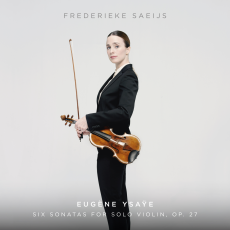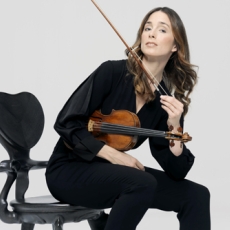Frederieke Saeijs - Ysaye: Six Sonatas - MusicWeb International
Along with the sonatas and
partitas of Bach, Eugène Ysaÿe's sonatas are at the pinnacle of the repertoire
at the disposal of the violinist playing alone. Though their composition is
separated by two centuries, there is a close relationship between these two
sets, not least because hearing Joseph Szigeti perform Bach was the initial
inspiration for Ysaÿe. If Bach's work was the foundation-stone, the edifice
that Ysaÿe constructed owes a great deal to the string techniques and the
musical language available to him in 1923. As he said: "At the present day the
tools of violin mastery, of expression, technique, mechanism, are far more
necessary than in days gone by. In fact they are indispensable, if the spirit
is to express itself without restraint."
The Dutch violinist Frederieke Saeijs is
perhaps less known outside The Netherlands than some big names of the violin.
She achieved international recognition by winning the 2005 Long-Thibaud
International Violin Competition in Paris and recently gave a warmly received
account of Oliver Knussen's concerto at the Barbican.
Only one instrument may be involved but these are
big, indeed monumental and varied works and allow for many possibilities in
their interpretation. Saeijs herself says: "Anyone who wants to say something
with the music will have his or her own very interesting interpretation of the
piece! Like that, there will (can) never be too many recordings of a piece."
The field is not yet crowded, though a recent flurry of activity has seen fine
accounts by Alina Ibragimova and Kristóf Baráti added to the catalogue.
Older notable performances are those by Oscar Shumsky, Thomas Zehetmair and Leonidas Kavakos. This is
illustrious company indeed but Saeijs is not out of place in it.
There is an immediately obvious clue as to what
differentiates Saeijs's recital from the rest. Taking Ibragimova and Baráti as
benchmarks of modern performance, I looked at track timings. I found that each
movement of Saeijs's performance is longer than theirs, without exception, and several
by a large margin. I don't imply they are better or worse for that, but they
are certainly different. The more measured - by which I don't mean leisurely,
for the playing is anything but that - approach appears to allow for greater
dramatic contrast and emphasis, and a clearer delineation of the narrative
(only one of the works is explicitly titled ‘Ballade' but they all have a
feeling of story-telling about them). In other words, these big works get big
performances from Frederieke Saeijs.
It's worth taking a look at one of the sonatas in
detail to see how this works. Ysaÿe's second sonata, dedicated to the French
violinist Jacques Thibaud, has four contrasted movements, beginning with
‘Obsession'. In this, he quotes from the Preludio from Bach's Partita in E major BWV
1006, supposedly because it formed an ‘obsessive' part of Thibaud's daily
practice routine. Ysaÿe also weaves in the thirteenth century Latin hymn Dies Irae, a
melody which of course has been used by many other composers in all sorts of
contexts.
Why Ysaÿe exploited the Dies Irae is not clear - the notion that he
foretold his friend's death in a plane crash thirty years later is far-fetched
to say the least - but the result is very striking. In fact, he left no
explicit clue for its inclusion but it recurs (obsessively?) throughout the
sonata. Saeijs brings out the inherent drama by giving more weight to the
notes, by digging deeper, both physically and emotionally. In contrast, Kristóf
Baráti's more light-weight approach, like that of many others, simply makes
less of the music, though his throwaway statement of the Bach at the outset is
admirably insouciant.
In the second movement ‘Malinconia', Saeijs's
tempo is arguably too slow for the poco lento marking, though as with the rest of the
set, my patience wasn't tested. Her thin, colourless tone at the start of this
sad song shows a strong understanding of the music's depressive character.
The Dance des Ombres opens with a pizzicato figure where
Saeijs treats her instrument almost like a lute, plucking the strings with some
force. Ibragimova and Baráti are frankly more anaemic here and more perfunctory
in the legato melody of the Sarabande that follows, whereas Saeijs, entering
with no vibrato, takes her time to good effect. She treats the reprise more
warmly, underlining the musical narrative.
In the final movement, Saeijs derives her
undoubted furioso effect by the use of emphatic
contrasts rather than by sheer pace and gives due weight to the Dies Irae when it reappears at the end.
It's a similar story in the rest of the music on
the disc...I have no problem with Saeijs's more dramatic approach which is enhanced by
a typically top-notch recording from Linn.
On the evidence of this recording, Frederieke
Saeijs deserves much greater recognition and I hope we hear a lot more of her
in the future. She says she loves Bach best so how about that next? For the
moment, we have this admirable set to be going on with.

